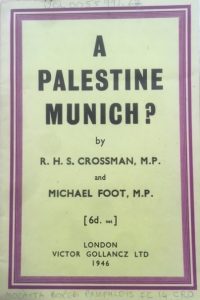New Jewish pamphlets
By Vanessa Freedman, on 24 June 2022
The Hebrew & Jewish Studies Collections in UCL Special Collections include a treasure trove of material in the form of pamphlets. There are over 9,000 pamphlets on a wide range of subjects throughout the field of Jewish Studies, particularly Anglo-Jewish history, Zionism and liturgy. The pamphlets date from 1601 onwards, and are in English, Hebrew, German and a number of other languages.
In 2019 we completed a project to make these rich collections available to scholars and the general public. They are now catalogued in Explore, the most fragile items have been conserved, and a selection of them have been digitised.
We haven’t finished developing this collection though, as we are still acquiring pamphlets by purchase or donation. If you have any pamphlets that you would like to donate, please contact the Hebrew & Jewish Studies librarian.
Here are a few highlights from our recent acquisitions.
 One of the highlights of the pamphlet collection is a large number of orders of service for a variety of national and communal occasions. This particular service was a cross-communal event: published by the Office of the Chief Rabbi of the United (orthodox) Synagogue, those leading the service also included Rev S.J. Roco of the Spanish and Portuguese Synagogue and Rev Morris Joseph of the (Reform) West London Synagogue of British Jews. The occasion was a spate of attacks against Jews that took place in newly-independent Poland after the First World War. There were over 130 attacks against Jews in Polish territories between 1918 and 1921, causing around 300 deaths.[1] The Hebrew title Bekhi tamrurim means ‘bitter cry’.
One of the highlights of the pamphlet collection is a large number of orders of service for a variety of national and communal occasions. This particular service was a cross-communal event: published by the Office of the Chief Rabbi of the United (orthodox) Synagogue, those leading the service also included Rev S.J. Roco of the Spanish and Portuguese Synagogue and Rev Morris Joseph of the (Reform) West London Synagogue of British Jews. The occasion was a spate of attacks against Jews that took place in newly-independent Poland after the First World War. There were over 130 attacks against Jews in Polish territories between 1918 and 1921, causing around 300 deaths.[1] The Hebrew title Bekhi tamrurim means ‘bitter cry’.
A Palestine Munich? by R.H.S. Crossman and Michael Foot
 In this ‘provocative’[2] pamphlet, published in 1946, left-wing backbench MPs Richard Crossman and Michael Foot (later leader of the Labour Party) attack the Labour Government’s policy on Palestine. They criticise the government for indecision and compare the restriction of Jewish immigration in order to avoid Arab opposition to the pre-war appeasement of Hitler (hence the title). The pamphlet argues for the partition of Palestine to form a Jewish state and an enlarged Transjordan.
In this ‘provocative’[2] pamphlet, published in 1946, left-wing backbench MPs Richard Crossman and Michael Foot (later leader of the Labour Party) attack the Labour Government’s policy on Palestine. They criticise the government for indecision and compare the restriction of Jewish immigration in order to avoid Arab opposition to the pre-war appeasement of Hitler (hence the title). The pamphlet argues for the partition of Palestine to form a Jewish state and an enlarged Transjordan.
And finally, a fascinating oddity:
Teʻudah Yehudit = Idisher doḳumenṭ = Jewish certificate
 This ‘Jewish Certificate’, in Hebrew, Yiddish, English and Arabic, looks like a passport and includes space for the holder’s photograph, signature and personal details. It proclaims that ‘the bearer of this certificate is a Jew not a Zionist and has no connection with the nationalist movement which has gained control over the Holy Land and turned it into a Zionist state by falsely assuming the Jewish names of Zion and Israel’. It was produced in 1976 or 1977 by the anti-Zionist ultra-Orthodox group Neturei Karta, some of whose members refuse to carry an Israeli identity card[3].
This ‘Jewish Certificate’, in Hebrew, Yiddish, English and Arabic, looks like a passport and includes space for the holder’s photograph, signature and personal details. It proclaims that ‘the bearer of this certificate is a Jew not a Zionist and has no connection with the nationalist movement which has gained control over the Holy Land and turned it into a Zionist state by falsely assuming the Jewish names of Zion and Israel’. It was produced in 1976 or 1977 by the anti-Zionist ultra-Orthodox group Neturei Karta, some of whose members refuse to carry an Israeli identity card[3].
[1] Anna Cichopek-Gajraj and Glenn Dynner, “Pogroms in Modern Poland, 1918–1946,” in Pogroms: A Documentary History, ed. Eugene M. Avrutin and Elissa Bemporad (Oxford: Oxford University Press, 2021), 193.
[2] Kenneth O. Morgan, “Foot, Michael Mackintosh (1913–2010), journalist, politician, and author,” in Oxford Dictionary of National Biography (2016).
[3] Menachem Friedman, “Neturei Karta,” in Encyclopaedia Judaica, ed. Michael Berenbaum and Fred Skolnik (Detroit, MI: Macmillan Reference USA, 2007).
 Close
Close












